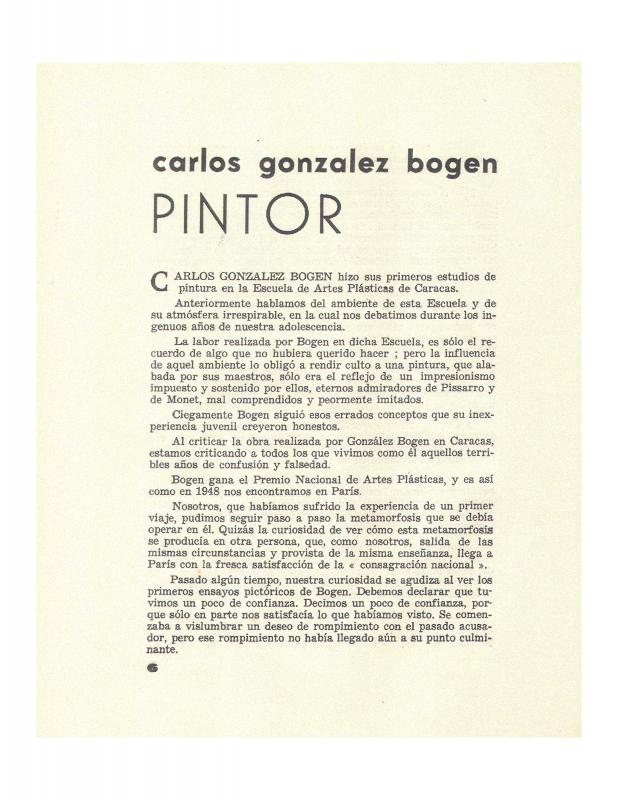Los Disidentes was a group started in Paris in 1950 by a number of Venezuelan artists and writers who lived there from 1945 to 1952. From their home base in Paris they decided to challenge the official education provided by the Escuela de Artes Plásticas de Caracas, which was based specifically on landscape painting and nativist art. In the spirit of their name, Los Disidentes sought to breathe new life into traditional and academic art through an assimilation of the values espoused by European abstraction. The painters in the group included the author of this article, Carlos González Bogen (see also “La escuela ‘de los paisajistas’ de Caracas” [doc. no. 813695]), Pascual Navarro, Luis Guevara Moreno, Alejandro Otero (“Mateo Manaure en la pintura: Un joven pintor venezolano, en viaje hacia París” [doc. no. 813639], “Del arte abstracto” [doc. no. 813611], “Poetas: Críticos de arte” [doc. no. 813445], “Las ‘placas al mérito’ y la juventud” [doc. no. 813429], and “Gastón Diehl promulga y espera una resurrección del espíritu impresionista en Venezuela?” [doc. no. 813625]), Mateo Manaure (“Carlos González Bogen: Pintor” [doc. no. 813583]), Narciso Debourg (“En torno a la pintura de hoy” [doc. no. 813597]), Perán Erminy (“Alrededor de la historia de ‘Los Disidentes’” [doc. no. 813463]), Rubén Núñez, Dora Hersen, and Aimée Battistini, as well as J. R. Guillent Pérez, who was a philosophy student at the time (“Lo latinoamericano y lo occidental [Parte I]” [doc. no. 813723], and “Lo latinoamericano y lo occidental: (Continuación)” [doc. no. 813478]). They were later joined by other Venezuelan artists such as Armando Barrios, Miguel Arroyo, Oswaldo Vigas, Omar Carreño, Alirio Oramas, and Régulo Pérez. They published a magazine, named after the group, Los Disidentes, which carried all their news, and appeared a total of five times.
This brief article by the painter, sculptor, and muralist Carlos González Bogen (1920–92) appeared in the fifth issue of Los Disidentes magazine. It was the third and last in the series of articles about the landscape painters of the EAPAAC, which was commonly referred to as “La Escuela de Caracas,” the Caracas School. The first article in the series, also by González Bogen, entitled “La Escuela de ‘los paisajistas’ de Caracas,” appeared in the second issue of the group’s magazine (Paris 1950). The second was the anonymous report published in the Márgenes column in the newspaper Últimas Noticias, entitled “De nuevo Los Disidentes” which referred to the first article. In this third article (also entitled “De nuevo Los disidentes”), which referred to the second in the series, González Bogen set out to make a statement, stressing the standards of bad taste that were still, even in 1950, very much in evidence in journalistic reporting—and even in some works of criticism—in Venezuela. These were the very opposite of everything Los Disidentes stood for, in their writings and in their art. In addition to pointing out the banality of the pseudo-artistic opinions expressed by the journalist(s) in question, the Venezuelan painter’s article also identified the negative traits in both the critique and in contemporary Venezuelan society, referring to the preference for politically-inspired adulation (and public relations) rather than an appreciation of the artist’s skills. In commenting on some of the journalist’s words, such as the attempt to praise the painter Manuel Cabré by comparing him to the Venezuelan academic painter Arturo Michelena, the disidente mentions the scant importance of Venezuelan art in the nineteenth century.
The complementary, anonymous text “Márgenes: De nuevo Los Disidentes” can be found in [doc. no. 813793].












